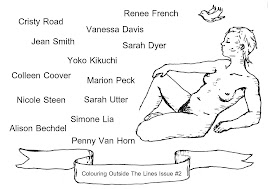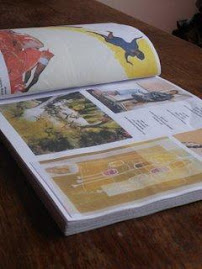

Missy Kulik
Location: Athens, Georgia via Pittsburgh, Pennsylvania
Currently working on: distribution of my self-published book, Personal Charm: A Collection of Comics
Day job: I am a product designer and graphic designer for the world's largestsupplier of balloons and coordinating gifts items. I also do freelance design and illustration.
3 Likes: Amigurumi, Paris, Fluevogs
3 Dislikes: Too much tv and internet, invasion of personal space, liars
Daily Inspirations: Zines, magazines, music, driving, trapeze class, and reading
People & artists you admire: John Porcellino, Raoul de la Cruz, T. Edward Bak
Superpower you would most like to possess: Invisibility
- - -
This interview took place in mid July 2005. All images reproduced with kind permission © Missy Kulik.
- - -
Hi Missy, how are you? What are you up to at the moment?
I have just finished Personal Charm, my self-published book. It compiles my favourite comics I made when I did my zine, Pocket, as well as comics from other zines, like Roctober.
You’ve worked for over 15 years self-publishing your own cartoons and zines, how did you get started with these?
When I first started reading zines, I was inspired to join in and make comics. I drew for a number of pen pals' zines, never thinking I can do it myself, really. Jake Austen of Roctober suggested doing a compilation once I had enough work together. The first issue of Pocket had hand-drawn covers and was printed by my dad.
How do you think self-producing & distributing has affected your relationship and access to your cultural production and artistic talent?
I really feel like I have come a long way from producing zines and minis. Not to sound silly, but it saved my life. It makes me feel less alone knowing I connect with people who read my comics and view my artwork.
How important and useful is your graphic design education within your everyday art creation?
Well, on a daily basis, at my day job, I use my design background in designing products for the general public. I sketch designs, use a computer, and send out artwork. At home, those skills come into play when I layout a book, sketch a panel, or cut and paste a collage. I think about all the basic design techniques when I create.
Your environment and what you interact with often enters your work, for example your possessions such as your soft toys, lyrics from songs you listen to, the cloud formations that you view, or things such as your cat.How important is your everyday environment in terms of inspiring your art?
This is very vital to my creativity because I am obsessed with all those things you mention. I am a cheerleader for my cat, I have tea parties with my toys, I wish I could eat clouds!
A number of your projects have been collaborative ventures, either with individuals, or with collectives of other artists. I’m thinking in particular of your joint / split comics with John Porcellino, your involvement with the Month Of Softies craft project, and your comics for Flagpole, (your local culture/music magazine), amongst other things.
How important is collaborative/community artwork to you?
Is it important for you to feel a part of a community of artists, a culture of creativity?
How do you become involved with these projects?
I have been pen pals with John Porcellino since I was in high school, so it seemed like a natural thing to do a split together. I admire his work and that he continues to produce stuff that is so on point.
I found the Month of Softies online and decided to contribute. I really like the idea of that and only recently became comfortable using the internet as getting the word out about my art and participating in such things.
As for the Flagpole Magazine, my pal T. Edward Bak was drawing a weekly strip. Flagpole was looking for other local comics people so they can have a full page devoted to comics each week. I have been doing that since November 2004.I feel that having a support system is vital to keep going with projects. I still write to a number of pen pals, I draw almost weekly with T. Edward Bak, and I am constantly having people find my work via the internet. It is good to know there is an indie community out there!
Your artwork has been described, amongst other things, as: ‘chockfull of adorable’, ‘so much fun’, ‘cute, imaginative and just plain silly’ And while this is exactly why I adore your work, a comment by Joe Meno springs to mind. He questions:
‘is it OK for art to be nice? At this moment, with the world spinning like a gear is missing from its rusty engine, with the clatter of larger conflicts like greed, war, poverty and apathy roaring everywhere, shouldn’t artists be responsible for challenging, postulating, inverting and forcing change? Maybe. Or maybe not. Maybe the artist has more than one responsibility. Maybe the complexities of the world demand more than one kind of art’.
What are your thoughts on this, and do you feel that your art work fits into either of the opposing thoughts regarding ‘nice’ art work, and the complex nature of peoples needs from art?
I don't intentionally get up in the morning and say "I am going to create nice artwork today!" but I know I have been seen as only being able to do one thing. I do not know how this came to be, but that's initial reactions to my work. I am fine with that, to an extent. I am capable of doing more than one thing, and I know it. At least I am getting a reaction. I was talking to a friend about the news on NPR the other day. I agree with his thoughts on saying that to have an active underground usually happens when the mainstream is out of control. Sometimes it is refreshing to see something positive, reassuring, or silly to feel like things are going to be okay.
What are your thoughts on the notion of there being a ‘responsibility within art’ at all?
What are your thoughts on the notion of there being a ‘responsibility within art’ at all?
It all depends on what the viewer takes from the art.
Joe Meno continues his quote by stating: ‘It becomes clear that there are a million worlds that need saving, the smallest of which contains the remnants of our imaginations, and the best art, political or not, asks us to begin there, in the realm of the untold, unrealized possibility’ I love this quote, and the emphasis on possibility and imagination. How important are the elements of Possibility and Imagination in your art work?
I love creating places for readers to imagine. My comics are daydreams on paper, even if it is something mundane, like eating toast.
Do you find traditionally ‘feminine’ terminology such as nice (or for that matter, ‘cute‘ or ‘adorable’) restrictive from your position of a female artist, or are such feminine ideologies something you hope to embrace in your art?
My first thought to that is, "what's wrong with being nice?"I used to not like having everyone say my comics were "cute," but I have come to embrace that within the last few years. I think it makes people feel like I one have one thing to offer, but that's not so. Comics are only one of the many things I do!
Expanding this question, do you think it is important for female artists to challenge the confines and aesthetics of words & styling such as ‘cute’ or ‘nice’ in order to re-construct and re-interpret traditionally ‘female’ art-forms, such as ‘gentle’ or ‘feminine’ forms, from a modern female standpoint?
I know I am a minority in the comics world, but I don’t think of it as a big deal. I do not feel it is my responsibility to change how women are viewed with my work. If I inspire more girls to do comics, art, or music, that rules.
Producing the comics and zines you do for the past 15 years, what has driven your commitment to the DIY community, and drives your continued cultural production?
I do this for my own well being, it is my outlet. I really don't know what else I would be doing if I didn’t discover the DIY community.
Is the DIY ‘scene’/community continually inspiring and important to you?
Yeah, it is great to see new stuff all the time. I do miss the days before the internet, though, where you had to write, read, and discover on your own.
How have you managed to curb DIY burnout within your prolific and varied art production?
I sometimes have to take time off form a project and get away from it for a while. I usually am doing ten things at a time, so there is always something else going on.
I have been keen to explore, on one of your websites, your Collage work as I’d only been predominantly aware of your comic/illustration work before. How do you produce these collages?
How does producing your collages, using alternate art skills, materials and techniques differ from producing your cartoons?
My collages are cut paper, mostly magazines.The collages are just a different way of thinking; they are more immediate than the comics are. There are stories in the collages, just like the comics. They are less funny, though. Ha ha.
Is it liberating to explore other mediums, and to utilize and promote your craft skills within this artwork?
Yes! I love learning new ways of doing things. There is so much to learn and do, and so little time. I feel like pulled taffy when I think about it.
The titles and content of your cartoon zines, such as: Cloud Picnic, Elves, Sunshine Factory, Puffy White Clouds, Where’s a Cookie, featuring, amongst others, elves, pixies, cats, birthday cakes, stuffed toys, cookies and jellycopters, all inspire a magical, cheerful, enchanting ‘escapism’.
Is this a fair, accurate emotional response to your work?
What emotions does the work inspire in you?
I live in a very daydreamy world. I like to be positive and feel comfort in my surroundings. I like to think this is reflected in my work, like you have joined my secret club when you read this stuff.
Do you find that producing zines of your artwork makes audiences engage more with your artwork, since they actively have to read, and handle and participate with your work, as opposed to if it was at a distance to them in a gallery? Is audience engagement and participation important to you?
Art should be for everyone. I like the idea of hand making something everyone can have, share, carry with them. This is true for my comics, as well as my collages and handmade goodies on my website.
Other than quoting lyrics in your work, you are also creatively involved with music by designing records and record sleeves. Do you find that there is a close relationship between the creativity in the ‘music world’ and the ‘art world’ that draws you to working with and being inspired by music and bands?
Sure, the bands I have done sleeves for are people I totally respect and love. DIY or die!
What are the most satisfying and enjoyable aspects of creating your artwork?
I really love meeting people in person, or having someone say "Your comic is the first thing I read when I open the Flagpole!" I love the positive reactions - it keeps me going.















No comments:
Post a Comment